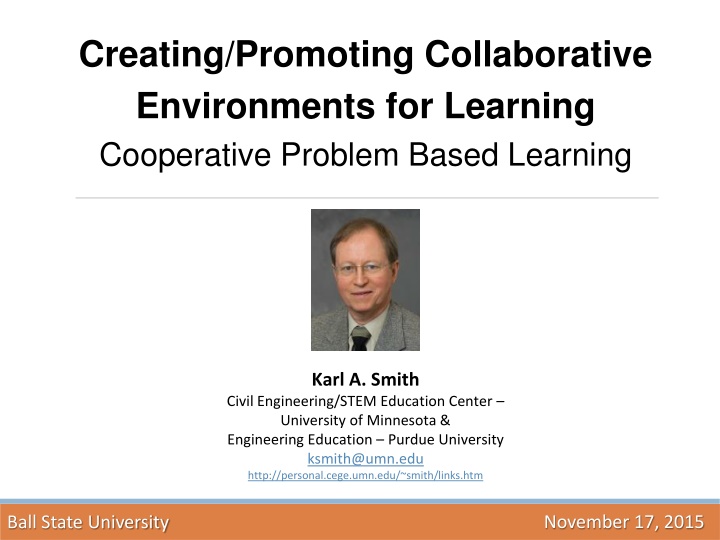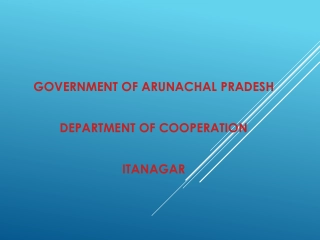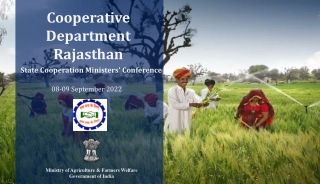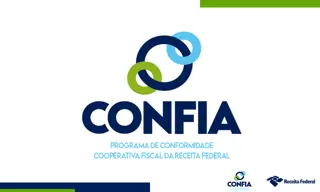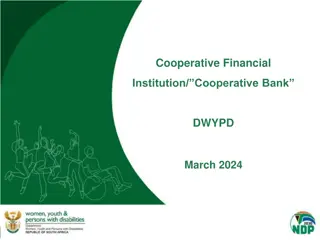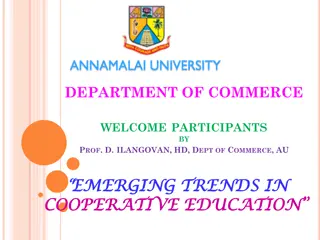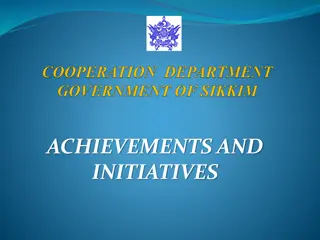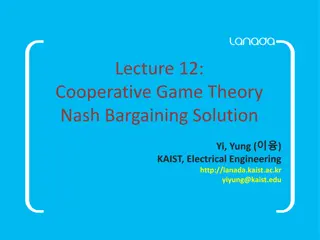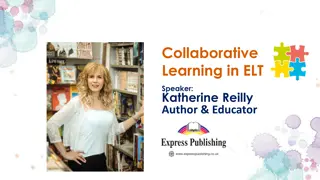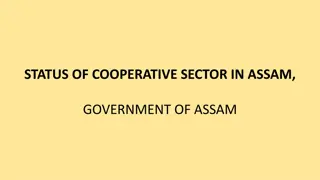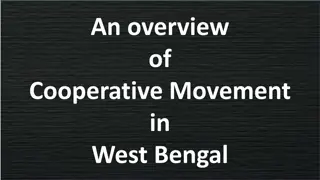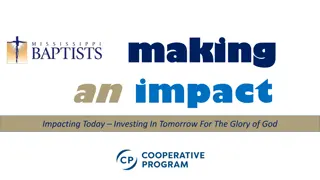Promoting Collaborative Environments for Cooperative Problem-Based Learning
Explore key concepts in creating, promoting, and structuring collaborative environments for cooperative problem-based learning in educational settings. Learn essential features of effective teamwork, high-performing teams, and formal cooperative learning. Discover strategies to increase student engagement through evidence-based teaching practices.
Download Presentation

Please find below an Image/Link to download the presentation.
The content on the website is provided AS IS for your information and personal use only. It may not be sold, licensed, or shared on other websites without obtaining consent from the author.If you encounter any issues during the download, it is possible that the publisher has removed the file from their server.
You are allowed to download the files provided on this website for personal or commercial use, subject to the condition that they are used lawfully. All files are the property of their respective owners.
The content on the website is provided AS IS for your information and personal use only. It may not be sold, licensed, or shared on other websites without obtaining consent from the author.
E N D
Presentation Transcript
Creating/Promoting Collaborative Environments for Learning Cooperative Problem Based Learning Karl A. Smith Civil Engineering/STEM Education Center University of Minnesota & Engineering Education Purdue University ksmith@umn.edu http://personal.cege.umn.edu/~smith/links.htm November 17, 2015 Ball State University
Session Layout Session Layout Welcome & Overview Teamwork High Performing Teams Teamwork Skills Cooperative Learning Key Concepts Formal Cooperative Learning Task Groups Challenge-based Learning Cooperative Problem-based Learning Applications
Overall Goal Overall Goal How to design courses to increase student engagement Build your knowledge of Evidence-Based Teaching Practices and your implementation repertoire
Cooperative Problem Based Cooperative Problem Based Learning (CLPBL) Objectives Learning (CLPBL) Objectives Participants will be able to list and describe essential features of the instructor s role in implementing CLPBL Participants will be able to elaborate on multiple ways Positive Interdependence and Individual Accountability were structured Participants will identify features to implement in their own courses
Structuring Teamwork in the Structuring Teamwork in the Classroom Classroom Formal Cooperative Learning Task Groups
Design team failure is usually due to failed team dynamics (Leifer, Koseff & Lenshow, 1995). It s the soft stuff that s hard, the hard stuff is easy (Doug Wilde, quoted in Leifer, 1997) Professional Skills (Shuman, L., Besterfield-Sacre, M., and McGourty, J., The ABET Professional Skills-Can They Be Taught? Can They Be Assessed? Journal of Engineering Education, Vo. 94, No. 1, 2005, pp. 41 55.)
Teamwork High-performing Cooperative Group PERFORMANCE LEVEL Cooperative Group Individual Members Traditional Group TYPE OF GROUP Pseudo-group
Reflection and Dialogue Reflection and Dialogue Individually reflect on the Characteristics of High Performing Teams. Think/Write for about 1 minute Base on your experience on high performing teams, Or your facilitation of high performing teams in your classes, or Or your imagination Discuss with your team for about 3 minutes and record a list
Characteristics of High Performing Characteristics of High Performing Teams Teams ? ?
A team is a small number of people with complementary skills who are committed to a common purpose, performance goals, and approach for which they hold themselves mutually accountable: SMALL NUMBER COMPLEMENTARY SKILLS COMMON PURPOSE & PERFORMANCE GOALS COMMON APPROACH MUTUAL ACCOUNTABILITY --Katzenbach & Smith (1993) The Wisdom of Teams
Hackman Hackman Leading Teams Leading Teams Real Team Compelling Direction Enabling Structure Supportive Organizational Context Available Expert Coaching Team Diagnostic Survey (TDS) https://research.wjh.harvard.edu/TDS/ 12
Edmondson Edmondson - - Teaming Teaming Learning to team, teaming to learn Teaming process (bottom-up) Teaming mindset adopted Reflection/feedback Interdependent action unfolds Coordination of steps and hand-offs Individuals communicate Recognize need for teaming Four pillars of effective teaming Speaking up Collaboration Experimentation Reflection "Teaming is the engine of organizational learning."
Successful teams share several defining characteristics: 1. Everyone on the team talks and listens in roughly equal measure, keeping communication short and sweet. 2. Members face one another, and their conversations and gestures are energetic. 3. Members connect directly with one another not just with the team leader 4. Members carry on back-channel or side conversations. 5. Members periodically break, go exploring outside the team, and bring information back. The most valuable form of communication is face-to- face. E-mail and texting are least valuable. Pentland (2012) 19 https://hbr.org/2012/04/the-new-science-of-building-great-teams
Cooperative Learning is instruction that involves people working in teams to accomplish a common goal, under conditions that involve both positive interdependence (all members must cooperate to complete the task) and individual and group accountability (each member is accountable for the complete final outcome). Key Concepts Positive Interdependence Individual and Group Accountability Face-to-Face Promotive Interaction Teamwork Skills Group Processing http://personal.cege.umn.edu/~smith/docs/Smith-CL%20Handout%2008.pdf
Teamwork Skills Teamwork Skills Communication Listening and Persuading Decision Making Conflict Management Leadership Trust and Loyalty Chapters 3, 4, 5 & 6
Team Charter Team Charter Team name, membership, and roles Team mission Anticipated results (goal) Specific tactical objectives Ground rules/ Guiding principles for team participation Shared expectations/aspirations pp. 60-61, 204-205
Group Ground Rules Contract Form (Adapted from a form developed by Dr. Deborah Allen, University of Delaware) Project groups are an effective aid to learning, but to work best they require that all groups members clearly understand their responsibilities to one another. These project group ground rules describe the general responsibilities of every member to the group. You can adopt additional ground rules if your group believes they are needed. Your signature on this contract form signifies your commitment to adhere to these rules and expectations. All group members agree to: 1.Come to class and team meetings on time. 2.Come to class and team meetings with assignments and other necessary preparations done. Additional ground rules: 1. 2. If a member of the project team repeatedly fails to meet these ground rules, other members of the group are expected to take the following actions: Step 1: (fill in this step with your group) If not resolved: Step 2: Bring the issue to the attention of the teaching team. If not resolved: Step 3: Meet as a group with the teaching team. The teaching team reserves the right to make the final decisions to resolve difficulties that arise within the groups. Before this becomes necessary, the team should try to find a fair and equitable solution to the problem. Member s Signatures: Group Number:______________ 1.____________________________ 2.____________________________ 3.____________________________ 4.____________________________ 28
Why Emphasize Teamwork? Why Emphasize Teamwork? Student learning Essential transferrable skill development Key to innovation High priority for Employers
Discipline Discipline- -Based Education Research Based Education Research (DBER) Report (DBER) Report National Research Council Summer 2012 http://www.nap.edu/catalog.p hp?record_id=13362 ASEE Prism Summer 2013 National Research Council 2015 http://www.nap.edu/catalog/186 87/reaching-students-what- research-says-about-effective- instruction-in-undergraduate Journal of Engineering Education October, 2013
Engaged Pedagogies = Reduced Failure Rates Engaged Pedagogies = Reduced Failure Rates Evidence-based research on learning indicates that when students are actively involved in their education they are more successful and less likely to fail. A new PNAS report by Freeman et al., shows a significant decrease of failure rate in active learning classroom compared to traditional lecture Freeman, Scott; Eddy, Sarah L.; McDonough, Miles; Smith, Michelle K.; Okoroafor, Nnadozie; Jordt, Hannah; Wenderoth, Mary Pat; Active learning increases student performance in science, engineering, and mathematics, 2014, Proc. Natl. Acad. Sci.
Education for Life and Work Education for Life and Work 1. Introduction 15 2. A Preliminary Classification of Skills and Abilities 21 3. Importance of Deeper Learning and 21st Century Skills 37 4. Perspectives on Deeper Learning 69 5. Deeper Learning of English Language Arts, Mathematics, and Science 101 6. Teaching and Assessing for Transfer 143 7. Systems to Support Deeper Learning 185 http://www.nap.edu/catalog/13398/education-for-life-and-work-developing-transferable-knowledge-and-skills
Conclusion. A strong body of research conducted over several decades has demonstrated that team processes (e.g., shared understanding of team goals and member roles, conflict) are related to team effectiveness. Actions and interventions that foster positive team processes offer the most promising route to enhance team effectiveness; they target three aspects of a team: team composition (assembling the right individuals), team professional development, and team leadership. (p. 7) http://www.nap.edu/catalog/19007/enhancing-the-effectiveness-of-team-science
This is the story of these pioneers, hackers, inventors, and entrepreneurs who they were, how their minds worked, and what made them so creative. It s also a narrative of how they collaborated and why their ability to work as teams made them even more creative. The tale of their teamwork is important because we don t often focus on how central that skill is to innovation.
http://www.aacu.org/leap/public-opinion-research/2015-survey-resultshttp://www.aacu.org/leap/public-opinion-research/2015-survey-results
http://www.aacu.org/advocacy/leap/documents/Re8097abcombined.pdfhttp://www.aacu.org/advocacy/leap/documents/Re8097abcombined.pdf
The College Degrees And Skills In2015 (National Association of Colleges and Employers (NACE)) Skills Employers Most Want The NACE survey also asked employers to rate the skills they most value in new hires. Companies want candidates who can think critically, solve problems, work in a team, maintain a professional demeanor and demonstrate a strong work ethic. Here is the ranking in order of importance: http://www.forbes.com/sites/susanadams/2015/04/15/the-college-degrees-and-skills-employers-most-want-in-2015/
Top Three Main Engineering Work Top Three Main Engineering Work Activities Activities Civil/Architectural Engineering Total Management 45% Design 36% Design 39% Computer applications 31% Computer applications 20% Management 29% Burton, L., Parker, L, & LeBold, W. 1998. U.S. engineering career trends. ASEE Prism, 7(9), 18-21.
Active Learning: Cooperation in the Active Learning: Cooperation in the College Classroom College Classroom Informal Cooperative Learning Groups Formal Cooperative Learning Groups Cooperative Base Groups Notes: Cooperative Learning Handout (CL-College-814.doc) [CL-College-814.doc]
Cooperative Learning is instruction that involves people working in teams to accomplish a common goal, under conditions that involve both positive interdependence (all members must cooperate to complete the task) and individual and group accountability (each member is accountable for the complete final outcome). Key Concepts Positive Interdependence Individual and Group Accountability Face-to-Face Promotive Interaction Teamwork Skills Group Processing http://personal.cege.umn.edu/~smith/docs/Smith-CL%20Handout%2008.pdf
Comparison of Learning Groups Comparison of Learning Groups LESS STRUCTURED (TRADITIONAL) MORE STRUCTURED (COOPERATIVE) Low interdependence. Members take responsibility only for self. Focus is on individual performance only. High positive interdependence. Members are responsible for own and each other s learning. Focus on joint performance Individual accountability only Both group and individual accountability. Members hold self and others accountable for high quality work. Assignments are discussed with little commitment to each other s learning. Members promote each other s success. They do real work together and help and support each other s efforts to learn. Teamwork skills are emphasized. Members are taught and expected to use social skills. All members share leadership responsibilities. Teamwork skills are ignored. Leader is appointed to direct members participation. Group process quality of work and how effectively members are working together. Continuous improvement is emphasized. No group processing of the quality of its work. Individual accomplishments are rewarded.
Instructors Role in Formal Instructor s Role in Formal Cooperative Learning Cooperative Learning 1. Specifying Objectives (Academic and Social/Teamwork) 2. Making Decisions 3. Explaining Task, Positive Interdependence, and Individual Accountability 4. Monitoring and Intervening to Teach Skills 5. Evaluating Students' Achievement and Group Effectiveness
Understanding by Design Process Understanding by Design Process What should learners know, understand and be able to do? Identify the Desired Results How will we know if the learners have achieved the desired results? What will be accepted as evidence of learners understanding and proficiency? Learning Activities Aligned Determine Acceptable Evidence What activities will equip learners with the needed knowledge and skills? What materials and resources will be useful? Plan Learning Experience -Understanding by Design, Wiggins and McTighe (1998)
Decisions, Decisions Decisions, Decisions Group size? Group selection? Group member roles? How long to leave groups together? Arranging the room? Providing materials? Time allocation?
Optimal Group Size? Optimal Group Size? A. 2 B. 3 C. 4 D. 5 E. 6 0% 0% 0% 0% 0% 2 3 4 5 6
Formal Cooperative Learning Task Formal Cooperative Learning Task Groups Groups Page 48 Perkins, David. 2003. King Arthur's Round Table: How collaborative conversations create smart organizations. NY: Wiley.
Group Selection? Group Selection? A. Self selection B. Random selection C. Stratified random D. Instructor assign E. Other
Assigning Roles Assigning Roles Chapter 8: Group Roles and Responsibilities Roles Facilitator Checker Set-Up Materials Manager Safety Officer Reporter Dividing the labor
Group Processing Group Processing Plus/Delta Plus/Delta Format Format Delta ( ) Plus (+) Things Group Could Improve Things That Group Did Well
Formal Cooperative Learning Formal Cooperative Learning Types of Types of Tasks Tasks 1. Problem Solving, Project, or Presentation 2. Jigsaw Learning new conceptual/procedural material 3. Group Tests 4. Review/Correct Homework 5. Peer Composition or Editing 6. Reading Comprehension/Interpretation 7. Constructive Controversy
Challenge Challenge- -Based Learning Based Learning Problem-based learning Case-based learning Project-based learning Learning by design Inquiry learning Anchored instruction John Bransford, Nancy Vye and Helen Bateman. Creating High-Quality Learning Environments: Guidelines from Research on How People Learn http://books.nap.edu/openbook.php?record_id=10239&page=159
Cooperative Problem Cooperative Problem- -Based Learning Based Learning Format Format EVALUATION: Best answer within available resources or constraints. TASK: Solve the problem(s) or Complete the project. INDIVIDUAL ACCOUNTABILITY: One member from your group may be randomly chosen to explain (a) the answer and (b) how to solve each problem. INDIVIDUAL: Develop ideas, Initial Model, Estimate, etc. Note strategy. COOPERATIVE: One set of answers from the group, strive for agreement, make sure everyone is able to explain the strategies used to solve each problem. EXPECTED BEHAVIORS: Active participating, checking, encouraging, and elaborating by all members. EXPECTED CRITERIA FOR SUCCESS: Everyone must be able to explain the model and strategies used to solve each problem. INTERGROUP COOPERATION: Whenever it is helpful, check procedures, answers, and strategies with another group.
First Course Design Experience First Course Design Experience UMN UMN Institute of Technology Institute of Technology Thinking Like an Engineer Problem Identification Problem Formulation Problem Representation Problem Solving 57
Team Member Roles Team Member Roles Task Recorder Skeptic/Prober Process Recorder 58
Technical Estimation Problem Technical Estimation Problem EVALUATION: Best answer within available resources or constraints. TASK: INDIVIDUAL: Quick Estimate (10 seconds). Note strategy. Note strategy. INDIVIDUAL ACCOUNTABILITY: One member from your group may be randomly chosen to explain (a) your estimate and (b) how you arrived at it. COOPERATIVE: Improved Estimate (~5 minutes). One set of answers from the group, strive for agreement, make sure everyone is able to explain the strategies used to arrive at the improved estimate. EXPECTED BEHAVIORS: Active participating, checking, encouraging, and elaborating by all members. INTERGROUP COOPERATION: Whenever it is helpful, check procedures, answers, and strategies with another group. EXPECTED CRITERIA FOR SUCCESS: Everyone must be able to explain the strategies used to arrive at your improved estimate.
Group Reports Group Reports Estimate Group 1 Group 2 . . . Strategy used to arrive at estimate assumptions, model, method, etc.
*Based on First Year Engineering course Problem-based cooperative learning How to Model It published in 1990.
Subject-Based Learning Problem-Based Learning START Given problem to illustrate how to use it START Told what we need to know Apply it Problem posed Learn it Normative Professional Curriculum: 1. Teach the relevant basic science, Learn it Identify what we need to know 2. Teach the relevant applied science, and 3. Allow for a practicum to connect the science to actual practice.
Group Processing Group Processing Plus/Delta Plus/Delta Format Format Delta ( ) Plus (+) Things Group Could Improve Things That Group Did Well
